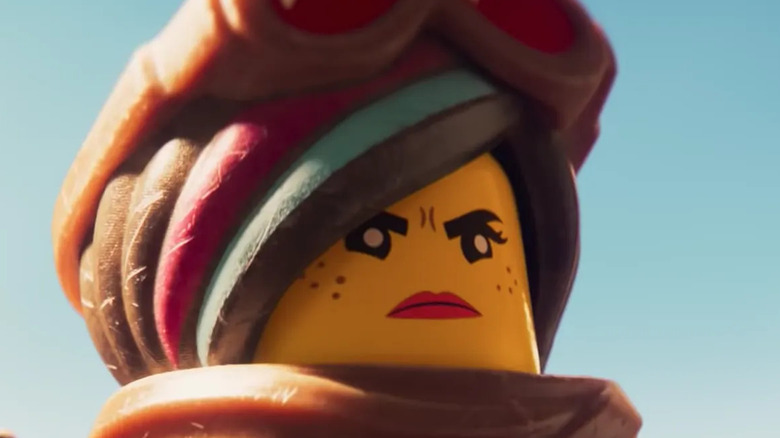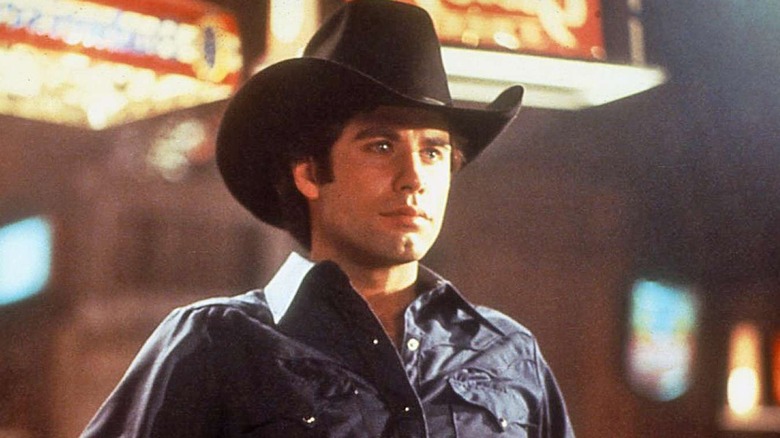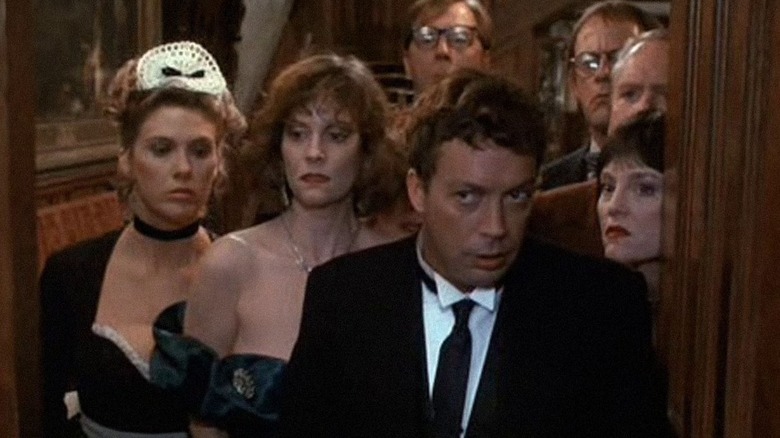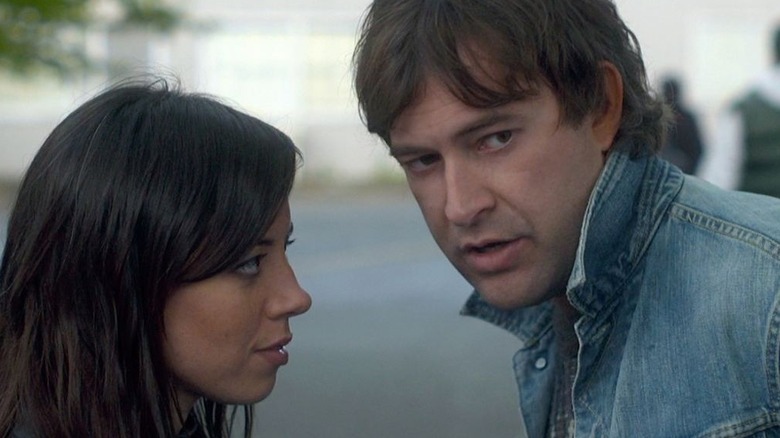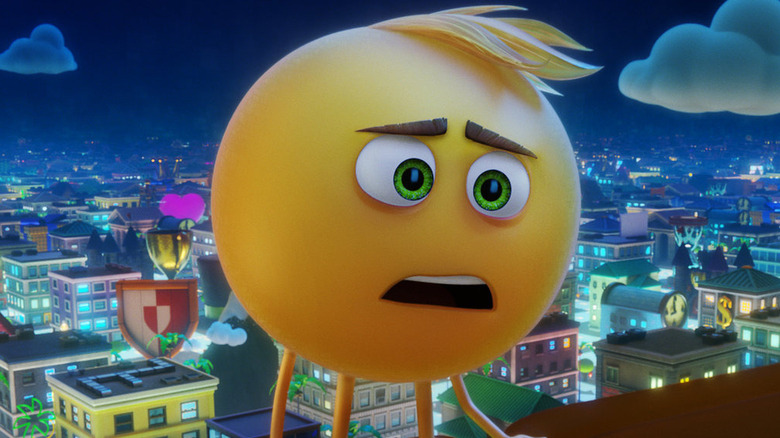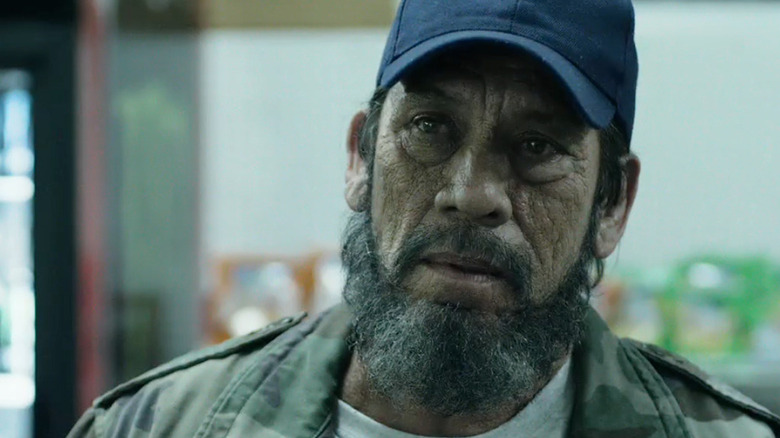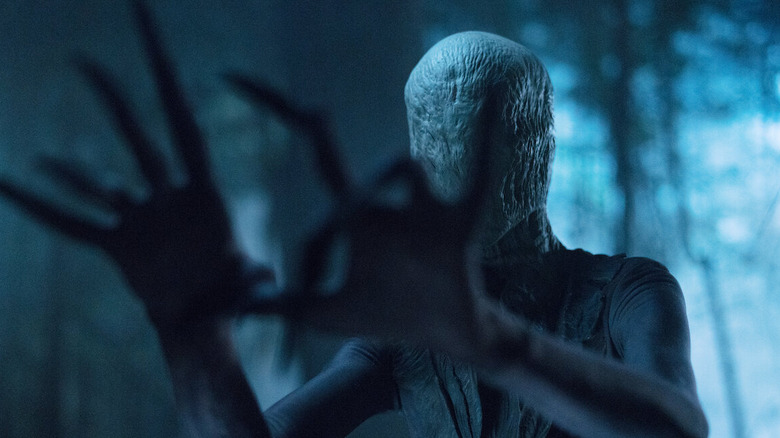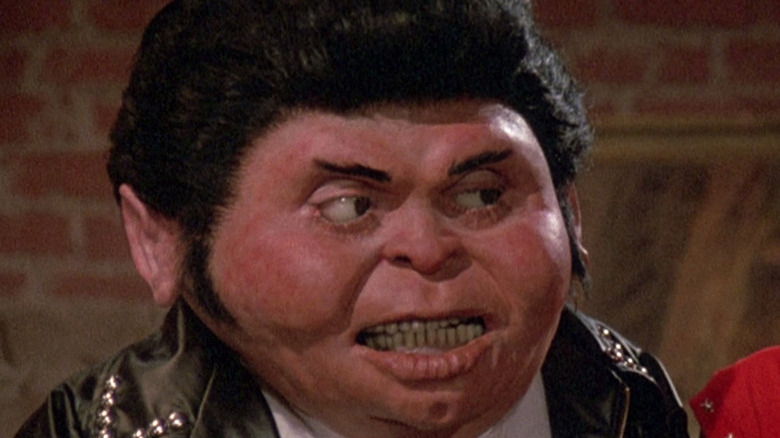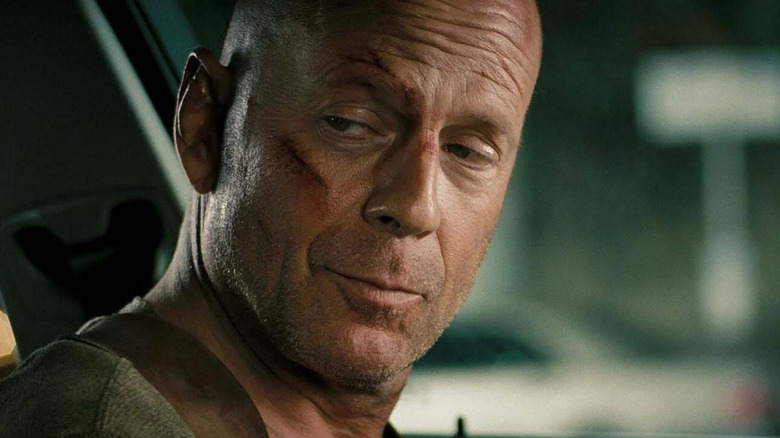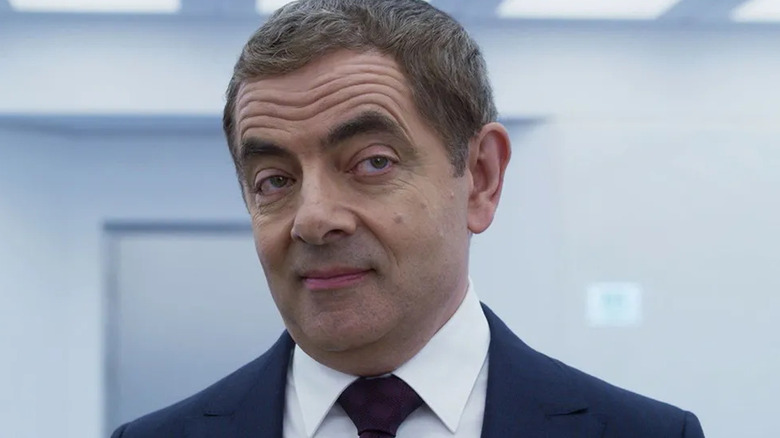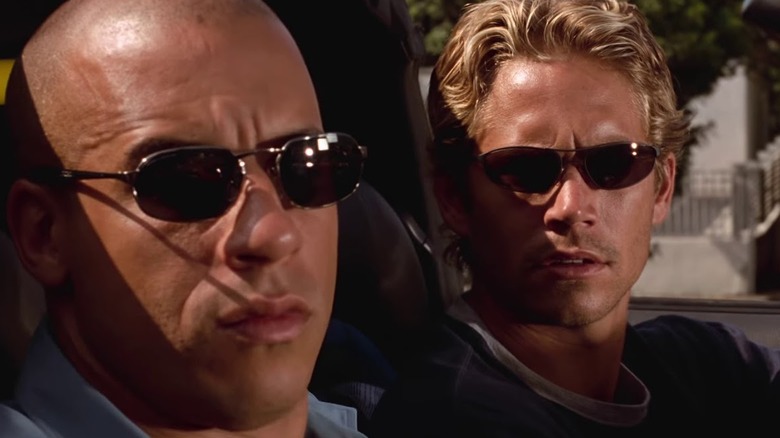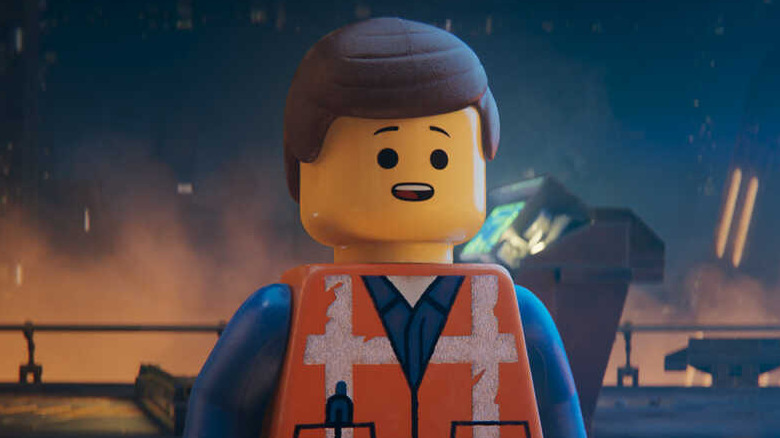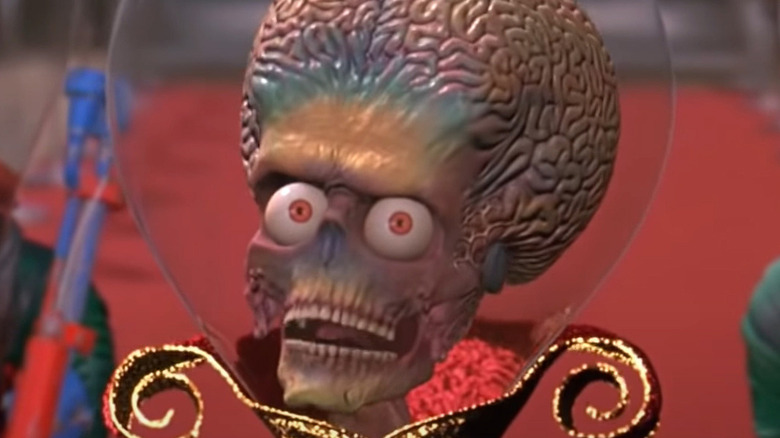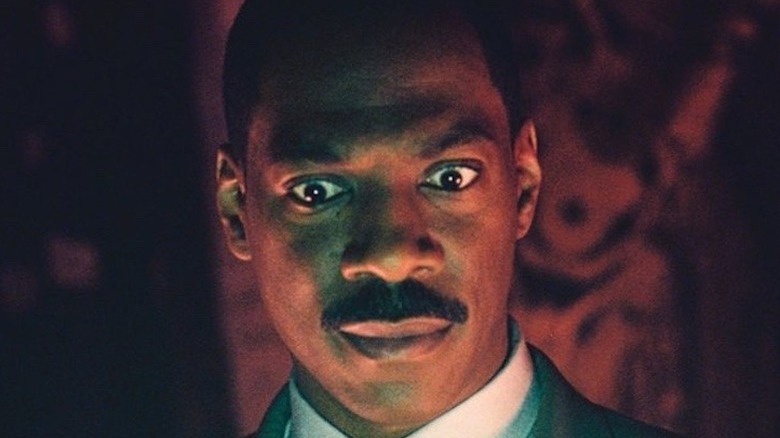Movies Based On Unexpected Things
Since the dawn of cinema, film studios have looked to unusual places for new ideas for their movies. Early films were often based on real events, or from classic novels like "Oliver Twist," "A Christmas Carol," and "Robinson Crusoe." As the decades went on, Hollywood filmmakers expanded their source material to include popular stage plays, and eventually remakes of older movies. By the 1970s, movies were being based on television shows, and by the 1990s it was comic books and video games. These days, it seems almost anything can form the basis of a major motion picture.
Look no further than 2021, where no less than four major releases were based on comic books, three based on video games, and countless novel adaptations. But every once in a while, Hollywood tries to find an oddball source to mine from for a new movie. Board games, toys, trading cards, and lately even internet memes have become the basis for new films.
We've put together a list of movies with the most bizarre, unusual, or otherwise unconventional source material. Some wound up being good movies, others duds. Read on to see if one of your favorites makes the list.
Urban Cowboy
Following career-defining performances in music-centric films "Grease" and "Saturday Night Fever," Hollywood star John Travolta took one in another: "Urban Cowboy," the 1981 romantic drama and neo-western set in modern day Houston, Texas. Travolta plays Bud, a typical macho cowboy, who sets his sights on Sissy, a proud, strong woman who is nobody's damsel. The film became famous for popularizing the mechanical bull thanks to a key scene where Travolta rides the metal beast to win Sissy's heart, but it turned out to be young rising star Debra Winger who'd steal the show.
But what makes the film unique is that it wasn't based on a memoir or a novel or even a musical, but a magazine article published in Esquire Magazine in 1978 titled "The Ballad Of The Urban Cowboy: America's Search For True Grit." The article chronicled a back-and-forth romance between two regular patrons of Gilley's, Dew Westbrook and Betty Helmer, which eventually formed the central romance for the film. More than 20 years after the movie debuted, Texas Monthly caught up with Westbrook, who acknowledged the real-life inspiration. He also admitted he had still never seen the film in its entirety, saying, "I've seen bits and pieces of it. Travolta did good. I think he did a good job from what I've seen."
Clue
It may seem a bit more commonplace now, with films like "Battleship" and "Ouija" being major motion pictures, but in 1984, the idea of a film based on a family board game likely seemed even more preposterous. Still, nobody has done it better since the original: "Clue," written and directed by Jonathan Lynn. The concept of taking a murder mystery game and fleshing it out into a farcical slapstick comedy whodunit seems like a recipe for disaster, but by embracing the inherent ridiculousness of the concept, it managed to deliver a fun and wholly unique film. What helped was the talented cast of the day's best comedic performers, including Tim Curry, Martin Mull, Christopher Lloyd, Lesley Ann Warren, Michael McKean, and Madeleine Kahn.
Infamous for its three different endings, the film found clever ways to make use of the silly in-game character names like "Colonel Mustard," "Mrs. White" and Mr. Green." It crafted a story that had the butler (Curry) ferreting out the killer by proposing multiple solutions involving secret passageways, a lead pipe, a candlestick, and other key elements pulled directly from the original game. An offbeat mix of "Sherlock Holmes" and "The Blues Brothers," it wasn't well-loved in its day — with Roger Ebert awarding it just two stars and knocking it for a "thin" screenplay — but has over the years become a true '80s cult classic.
Safety Not Guaranteed
The movie that turned Colin Trevorrow from indie spotlight filmmaker into a blockbuster Hollywood director, "Safety Not Guaranteed" was an oddball 2012 release starring Aubrey Plaza, Mark Duplass, Jake Johnson, and Kristen Bell. Plaza plays Darius, a newspaper intern who's tasked with investigating a mysterious classified ad that reads "Wanted: Somebody to go back in time with me. This is not a joke. ... I have only done this once before. SAFETY NOT GUARANTEED." Discovering that the man who placed the ad is a disaffected grocery store clerk hoping to change his past, the two connect and form an unlikely friendship, and eventually travel back in time.
Though not a box office smash of any kind, it was a modest success given its tiny budget, but earned near universal acclaim from critics. But as bizarre as the movie is, the story of its source material may top its unusual plot: It was inspired by an actual classified ad placed in issue of Backwoods Home Magazine. Placed in the magazine as a joke by the magazine's senior editor, it eventually became the talk of the town, even getting a mention by Jay Leno before being optioned for a feature film.
The Emoji Movie
From Hollywood's "How Ridiculous Can We Get?" files comes Sony's 2017 film, "The Emoji Movie." More or less a generic kids film about friendship, specialness, and other family-friendly life lessons, it uses the concept of cell phone emoji text icons to populate and visual its unique CGI world. It tells the story of Gene, a mult-expression emoji inside a smartphone world called Textopolis who travels through different apps (read: paid product placement) to find a way to become like everyone else and have just one unique face. Despite its cynical source material, the film managed to recruit an all-star cast, including Patrick Stewart, James Corden, Anna Faris, Christina Aguilera, and Sofia Vergara.
Savaged by critics, it infamously debuted to a zero percent score on review aggregator site Rotten Tomatoes (that has since improved to a modest 6%). The truth is that it's really just a forgettable animated adventure, like any number of films released every year direct to video or streaming. And to its credit, its use of the "emoji" for its world-building helped it stand out and attract the kind of attention it probably wouldn't have otherwise.
Bad Ass
One of the most prolific actors in Hollywood today, Danny Trejo had 21 credits in 2021, and over 400 and counting for his career, according to IMDb. But it was one of his 11 projects in 2012 that makes our list, an action drama called "Bad Ass." A throwback action flick in the vein of "Death Wish," the film follows a retired Vietnam veteran who gain fame thanks to a viral video of him fighting a group of abusive racist hoodlums on a bus. But when his best friend is killed in a violent alley confrontation, and the police don't want to do anything about it, he takes matters into his own hands.
Like many entries on this list, "Bad Ass" was not well reviewed, but became more talked about thanks to its unusual origins. The viral video in the film was based on a real life incident, a video that purported to show a man fighting back against thugs on a public bus, which turned him into a internet celebrity. Taking the man's story one step further, they spun a subsequent fictionalized murder mystery tale to give Trejo an opportunity to do what he does best: Be a total "Bad Ass."
Slender Man
Horror films are known for being "inspired" by real life events. Classics like "The House on Haunted Hill," "The Amityville Horror" and even "The Texas Chainsaw Massacre" were said to be based on true stories. But in 2018, a horror film was released based on an urban legend sparked by a viral internet meme, one that unfortunately became its own true story. The low budget indie slasher movie "Slender Man" was inspired by the creepypasta that first debuted in June of 2009, the result of an online competition on comedy website Something Awful to create a modern day myth. Based around a supernatural being that sometimes appears in old photographs in the form of a faceless man in a black and white suit and tie, the movie told the story of three girls who seek to summon the other worldly being when their friend goes missing — to horrifying results.
Once again, the resulting film was less than spectacular, resulting in a critical drubbing, but some blame a real life murder in Wisconsin inspired by the same viral meme for the film being rewritten, and its intensity softened. With the real life killings, also by a pair of young girls, happening two years before the film was made, and the meme itself already out-of-date, it makes one wonder what the studio was thinking by making it in the first place.
Garbage Pail Kids
In the mid 1980s, there were few things bigger than Garbage Pail Kids: A series of gross-out stickers sold at pretty much every corner store in America. Kids on playgrounds swapped them, stuck them to lockers, notebooks, skateboards, and pretty much anything with a flat surface. From "Adam Bomb" to "Nasty Nick," there was a never ending supply of disgusting kids. It was a true pop culture phenomenon, possibly unlike anything anyone had ever seen at the time, so of course it lead to further merchandising — and a feature film.
The problem was, of course, that the stickers were just a vehicle to deliver one-note sight gags; there was no story, little-to-no characters with an origin or backstory. "The Garbage Pail Kids" movie, released in 1987, invented an entirely new premise for the sickening looking little buggers: A race of aliens who came to Earth looking for a new home. It's often regarded as one of the worst films of the decade, but it's really no surprise. What did anyone expect from a movie created from a line of stickers designed to make you barf?
Live Free or Die Hard
After commercial success of the third "Die Hard" film, "Die Hard With A Vengeance," in 1993, it seemed like a fourth film would have been a no-brainer — but it took nearly a decade and a half to get it off the ground. With a roster of up-and-coming stars that saw aging action hero Bruce Willis joined by Timothy Olyphant, Mary Elizabeth Winstead, Justin Long, and Maggie Q, "Live Free Or Die Hard" gave John McClane a new terrorist plot to foil. This time, it was a diabolical cyber criminal who hacked into government computers in the hopes of disrupting the nation's infrastructure. But whereas the first two films in the series had been based on a pair of thriller novels and an unrelated screenplay, the fourth installment took its story from an article in Wired Magazine.
Written in 1997 by journalist John Carlin, the article posited a near future where supercomputers and information networks could become weaponized by terrorists. While the article speculated that warfare of the future might eschew rockets and missiles and instead be fought on a digital battleground, "Live Free Or Die Hard" was an over-the-top action movie, and still included plenty of explosions and traditional weaponry.
Johnny English
"Johnny English" somehow turned slapstick English comic Rowan Atkinson (better known as the silent but bumbling Mr. Bean) into a dashing man of action. Starring alongside Atkinson were pop singer Natalie Imbruglia, John Malkovich, and Ben Miller. In the film, English — a dim-witted lesser secret agent — is recruited to stop a terrorist from nabbing the nation's crown jewels after eliminating MI6's best super spies, leaving Atkinson's character the last best hope to thwart his villainy. It's fairly standard spy comedy stuff, and thanks to its small budget, was considered a success with more than $160M at the box office. It wasn't a blockbuster, but it was enough to net sequels, the latest of which, "Johnny English Strikes Again," landed in 2018.
With his own trilogy spanning nearly twenty years, "Johnny English" has become his own franchise — but some seem to forget that like the HBO show "Ted Lasso," the film series was actually an expansion of a set of TV commercials. Atkinson created the persona to market Barclaycard (as noted by Variety when the film was greenlit in 2000). Turning a popular commercial into a feature film had been done before, but this one found a trilogy worth of success, with all three movies doing fairly well at the ticket counter.
The Fast & The Furious
One of Hollywood's biggest franchises ever, "The Fast & The Furious" series features some of the most well-known names in the action genre: Vin Diesel, Michelle Rodriguez, Dwayne "The Rock" Johnson, Gal Gadot, and the late Paul Walker. Over the years the series of car films have gotten bigger, bolder, and more explosive (literally). It's easy to forget that when it all started in 2001 though, it was a simple story of a cop (Paul Walker) sent undercover to put an end to a notorious criminal and infamous street racer (Vin Diesel). It may have started as "Point Break" style action thriller, but each subsequent film has added more stars, more twists and turns, and more over-the-top action.
But back in 2001 when the first film launched, many didn't realize it was based on a magazine article in Vibe Magazine called "Racer X." The article explored the secret world of underground racing. In 2015, ahead of the release of the seventh installment in the series, Yahoo News interviewed the article's author, Ken Li. "The strange thing about the plot of the movie," he said, "was it was actually closer to the kind of story I was aiming to write with the article. I was trying to uncover some car theft ring, and edited that part out of the story."
The Lego Movie
From trading cards and stickers, to board games and action figures, Hollywood has somehow found a way to take all kinds of popular kids collectibles and adapt them into big budget feature films. Some have been reasonable successes like "Mars Attacks" but most have been bombs like "Garbage Pail Kids." That would all change in 2014, when Warner Bros. managed to take one of the most beloved children's toys of the last century and turn it into the biggest hit on this list. Building off of the relationship they'd forged with the Lego company on their "Star Wars" and "Harry Potter" toys and video games, the studio developed a clever family film set in a Lego world. The talented crew of voice actors included Chris Pratt in the role of Emmet Brickowski, the film's everyman hero, while Will Arnett, Elizabeth Banks, Nick Offerman, Allison Brie, Charlie Day, Liam Neeson, and Morgan Freeman rounded out the all star cast.
Thanks to the efforts of talented filmmakers, "The Lego Movie" proved that sometimes a generic, broad idea like building bricks can be the source of a great story and ultimately a blockbuster film. It spawned a number of sequels, became the envy of Hollywood executives for its clever formula, and turned directors Phil Lord and Chris Miller into in-demand directors.
Mars Attacks
We talk a lot about so-called all-star casts, but Tim Burton's 1996 special effects extravaganza "Mars Attacks" takes the cake in that regard. The tale of big-brained aliens from outer space arriving on Earth and vaporizing anything and everything was packed to the gills with A-Listers. The wall-to-wall stars included Pierce Brosnan, Danny DeVito, Jack Nicholson, Michael J. Fox, Sarah Jessica Parker, Natalie Portman, Pam Grier, Glenn Close, Annette Bening, and Jack Black. But rather than a remake of a '50s b-movie, "Mars Attacks" was adapted from a series of nickel-a-pack trading cards published by trading card giant Topps in 1962. The 55-card series told the story of the invasion in individual vignettes, filled with imagery deemed graphic and controversial for its time. Burton, however, chose not to capture the same level of serious brutality — opting for a sillier, light-hearted affair.
Netting mixed reviews, the film failed to deliver big box office results. The disappointment seemingly put a halt to Topps' card series and comics: No new sets came after the movie debuted in 1995, and the comic book series came to a close the same year. But you can't keep a good Martian down, and new comics and cards returned over decade later.
The Haunted Mansion
When Disney's "The Pirates Of The Caribbean" launched in 2003 to a massive box office haul, the studio was thrilled that a film based on a theme park ride had found such incredible success, sparking its own new franchise. But that same year Disney would release another film of note, "The Haunted Mansion," starring comedian and star Eddie Murphy. Like Johnny Depp's swashbuckling adventure series, the family-friendly horror film was based around a theme park ride (as noted by Variety in their review of the film), one of the oddest source materials you're likely to find. The movie followed a real estate agent named Jim Evers (Murphy) who struggles to balance work and family. Jim plans a weekend getaway with his wife and kids at a place called Gracey Manor. Unfortunately, the residence proves to be haunted, and adventure (and supposed hilarity) ensues.
Despite a robust budget and some pretty solid special effects, the film just couldn't find the same mammoth audience as "Pirates of the Caribbean." Though it wasn't exactly a flop, it didn't manage to hit Disney's lofty expectations and there were no sequels — though a remake appears to be on the horizon, as Deadline reported in 2021. Still, noted critic Roger Ebert didn't dismiss the film, and applauded its attempt to do more with the dark ride's premise, praising its ambition, even if it couldn't quite achieve what it set out to do.
